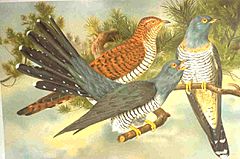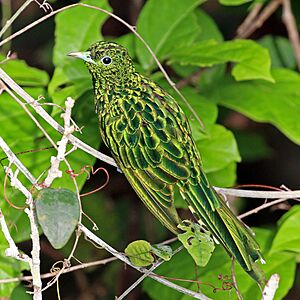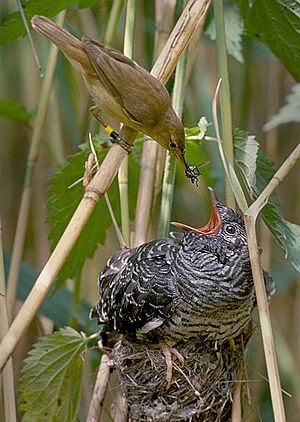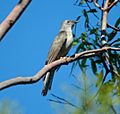Cuckoo facts for kids
Quick facts for kids Cuckoos |
|
|---|---|
 |
|
| Cuculus canorus: the male (front) is grey with dark bars; female grey morph (right) is similar, but with pinkish-buff edge to the throat. The less common red-brown 'rufus' morph is also female (left rear) | |
| Scientific classification | |
| Kingdom: | |
| Phylum: | |
| Class: | |
| Order: |
Cuculiformes
|
| Family: |
Cuculidae
Vigors, 1825
|
Cuckoos are a family of birds that are part of a larger group called Cuculiformes. This family is famous because some of its members are "nest parasites." This means they lay their eggs in the nests of other birds, letting those birds raise their young!
But not all cuckoos are nest parasites. The cuckoo family also includes other interesting birds like roadrunners, koels, malkohas, couas, coucals, and anis. Many cuckoos are known for a special type of parasitism called brood parasitism. This is when a cuckoo mother lays her eggs in another bird's nest, and the "host" parents then raise the baby cuckoo as if it were their own.
Contents
The Brood Parasite Cuckoo
The common cuckoo, Cuculus canorus, is a well-known example of a brood parasite. In many places, it's just called "cuckoo." These birds fly to Europe and northern Asia for the spring and summer. When winter comes, they travel to Africa and southern Asia.
Common cuckoos are greyish birds with slim bodies, long tails, and strong legs. When they fly, they can look a bit like a small bird of prey. The male cuckoo is dark grey with a blackish-brown tail that has white spots. Female cuckoos are similar but might have a reddish tint on their upper chest. Cuckoos love to eat hairy caterpillars. You can often find them where forests meet open fields.
The common cuckoo gets its name from the sound the male makes. It sings two notes that sound like "cu-ckoo." The female cuckoo doesn't make this sound; instead, she has a loud, bubbly call.
Laying Eggs in Other Nests
Common cuckoos do not build their own nests, and they don't raise their own young. Instead, the female cuckoo lays her eggs in the nests of other birds. Each female cuckoo usually chooses only one type of host bird. She lays camouflaged eggs that look very similar to the host bird's eggs. For example, a cuckoo that lays eggs in a reed warbler's nest will lay eggs that look like reed warbler eggs.
The female cuckoo spends a lot of time watching the nest she wants to use. She needs to find the perfect moment to lay her egg when the host parents aren't around. If she lays her egg too early, before the host bird starts laying, the host might notice it's not her egg and get rid of it. If she lays it too late, after the host has finished laying, that might also be noticed.
When the time is right, the female cuckoo quickly flies to the nest. She pushes one of the host's eggs out, lays her own egg, and flies away. This whole process takes only about 10 seconds! The host bird often doesn't notice the switch and continues to care for the eggs.
When the cuckoo chick hatches, it grows very quickly. It soon pushes the other eggs or host chicks out of the nest. By 14 days old, the cuckoo chick can be three times bigger than the adult host parents! The chick has a huge mouth that it opens very wide. It also makes a very fast "cheeping" sound that sounds like a whole nest full of host chicks. This tricks the host parents into behaving as if they have a nest full of their own babies.
About 56 cuckoo species in the Old World (Europe, Asia, Africa) and 3 in the New World (the Americas) are brood parasites. This means they only reproduce by laying their eggs in other birds' nests.
Cuckoo Egg Disguises
Female parasitic cuckoos are very good at specializing. They lay eggs that look like the eggs of their chosen host bird. This amazing skill has developed over time through natural selection. Birds that can tell the difference between cuckoo eggs and their own will throw out the cuckoo eggs. This means only the cuckoo eggs that look most like the host's eggs will survive.
Host birds also try to protect their nests. Birds whose nests are often targeted by cuckoos will sometimes gang up on cuckoos and chase them away from their area.
Parasitic cuckoos are grouped into different "gentes" (which means "lines" or "groups"). Each group specializes in a particular host species. This allows each group of female cuckoos to develop a specific egg color that matches their host. So, while the cuckoo species as a whole might use many different hosts, each line of female cuckoos specializes in just one host species.
The genes that control egg color are passed down only from the mother. This helps female cuckoos lay eggs that look like their host's eggs. It's thought that female cuckoos "learn" or "imprint" on the host species that raised them. Later, they will only lay eggs in the nests of that same species. Male cuckoos, however, can mate with females from any of these different lines.
The detailed and almost perfect way cuckoos trick other birds, and how host birds try to defend themselves, is truly amazing. Many host species can even spot and get rid of cuckoo eggs that look almost exactly like their own! This system is a great example of an evolutionary arms race. It's a type of co-evolution where two species constantly evolve in response to each other. Other birds, like cowbirds, also practice nest parasitism, but their methods are not as specialized as the cuckoo's.
Cuckoo Disguises and Migration
When male cuckoos and grey female cuckoos fly, they look a bit like a sparrowhawk. This might help protect them from other birds that might try to chase them away. This is a type of Batesian mimicry. We don't fully know why some female cuckoos are reddish-brown. It might be that because they are less common, other birds don't recognize them as easily.
Cuckoos only stay in their summer homes for about 10 weeks. For example, in Britain, they arrive in April, and the adults start flying to Africa by late June or early July. They usually arrive in Africa (or Asia) in August.
Cuckoos molt (change their feathers) twice a year. They change some feathers in the summer and completely change them in the winter.
- Davies, Nick 2015. Cuckoo. London: Bloomsbury.
- Wyllie, Ian 1981. The Cuckoo. London: B.T. Batsford.
Images for kids
-
The chestnut-breasted malkoha has bright skin around its eye.
-
Some species, like the Asian emerald cuckoo (Chrysococcyx maculatus), have shiny, iridescent feathers.
-
The great lizard cuckoo is a large cuckoo found on Caribbean islands.
-
The greater roadrunner is rarely seen flying.
-
Unlike most cuckoos, the Asian koel mainly eats fruit.
-
A brush cuckoo.
-
Blue coua (Coua caerulea).
-
Yellow-billed cuckoo (Coccyzus americanus).
-
Rufous-vented ground cuckoo (Neomorphus geoffroyi).
-
White-browed coucal (Centropus superciliosus).
See also
 In Spanish: Cucúlidos para niños
In Spanish: Cucúlidos para niños















